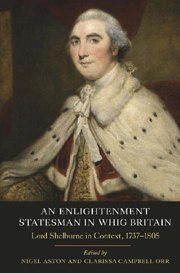Book contents
- Frontmatter
- Contents
- List of Illustrations
- List of Contributors
- Acknowledgements
- List of Abbreviations
- Introduction
- Part One Family, Piety, and Finance
- Part Two Politics
- Part Three The Bowood Circle Revisited
- 9 ‘Opening the Door to Truth and Liberty’: Bowood's French Connection
- 10 Lord Shelburne's Constitutional Views in 1782–3
- 11 Jeremy Bentham at Bowood
- 12 Shelburne and Perpetual Peace: Small States, Commerce, and International Relations within the Bowood Circle
- Index
- STUDIES IN EARLY MODERN CULTURAL, POLITICAL AND SOCIAL HISTORY
10 - Lord Shelburne's Constitutional Views in 1782–3
from Part Three - The Bowood Circle Revisited
Published online by Cambridge University Press: 05 September 2013
- Frontmatter
- Contents
- List of Illustrations
- List of Contributors
- Acknowledgements
- List of Abbreviations
- Introduction
- Part One Family, Piety, and Finance
- Part Two Politics
- Part Three The Bowood Circle Revisited
- 9 ‘Opening the Door to Truth and Liberty’: Bowood's French Connection
- 10 Lord Shelburne's Constitutional Views in 1782–3
- 11 Jeremy Bentham at Bowood
- 12 Shelburne and Perpetual Peace: Small States, Commerce, and International Relations within the Bowood Circle
- Index
- STUDIES IN EARLY MODERN CULTURAL, POLITICAL AND SOCIAL HISTORY
Summary
As suggested by the title of John Norris's study, the name of Shelburne conjures up the idea of reform. But what reform is it all about exactly? During his ministry from July 1782 to February 1783, Shelburne implemented a programme which combined the liberalization of trade with the reform of the tax system and the modernization of the administration. In Norris's opinion, parliamentary reform and, to a larger degree, reform of the executive and legislative bodies, did not represent a priority in Shelburne's ministerial agenda. Yet, a memoir written in 1783 by one of Shelburne's best friends, the French abbé Morellet, presents a vast programme which hinged on an ambitious institutional reform. According to Morellet, Shelburne wanted to reconsider the foundations of the British political system. His aim was to reach a new institutional balance in which the executive power would have been considerably strengthened.
Before approaching Morellet's account, it is first advisable to go back over Shelburne's ministry and over the problems raised by his management of affairs. The constitutional views which are set forth in Morellet's memoir invite us, in the second place, to wonder about the ideological dimension of Shelburne's plan. Finally, one must put Shelburne's constitutional views in a wider context, which, at first sight, seem anachronistic according to a Whig interpretation of History, emphasizing the growing importance of representative institutions. The European political context of the 1770s and 1780s challenges this view and throws some light on this fascinating political episode.
- Type
- Chapter
- Information
- An Enlightenment Statesman in Whig BritainLord Shelburne in Context, 1737–1805, pp. 215 - 232Publisher: Boydell & BrewerPrint publication year: 2011

